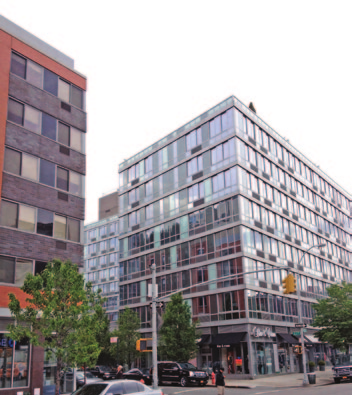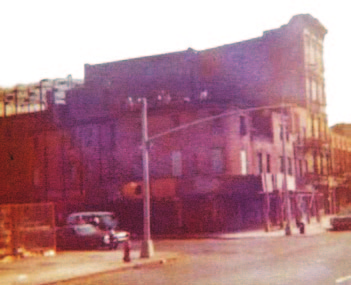How Music Works (46 page)
Authors: David Byrne
Tags: #Science, #History, #Non-Fiction, #Music, #Art

vet Underground, Neu!, and Faust, and from there to bands like Suicide and
onward. The trance sound made its way onto the club stages as well, with the volume and distortion turned way up.
Pop art from the sixties lingered on as a movement, mutating and becom-
ing more ironic as it drifted further from its origins. Compared to some of the dour work of the conceptualists and minimalists, one felt that at least these artists had a sense of fun. Warhol, Rauschenberg, Rosenquist, Lichtenstein,
and their kin were about embracing, in a peculiar, ironic way, a world with
which we were familiar. They accepted that pop culture was the water in which we all swam. I think I can speak for a lot of the musicians in New York at that time and say that we genuinely liked a lot of pop culture, and that we appreciated for workmanlike song craft. Talking Heads did covers of 1910 Fruitgum
Company and the Troggs, and Patti Smith famously reworked the über-prim-
itive song “Gloria” as well as the soul song “Land of 1,000 Dances.” Of course, our cover tunes were very different than those we would have been expected
to play if we had been a bar band that played covers. That would have meant
Fleetwood Mac, Rod Stewart, Donny & Marie, Heart, ELO, or Bob Seger. Don’t get me wrong, some of them had some great songs, but they sure weren’t singing about the world as we were experiencing it. The earlier, more primitive pop hits we’d first heard on the radio as suburban children now seemed like dia-monds in the rough to us. To cover those songs was to establish a link between one’s earliest experience of pop music and one’s present ambitions—to revive that innocent excitement and meaning.
If I were to diagram the art/music connections, I might say that the Ramones and Blondie were Pop-art bands, while Talking Heads were minimalist or
conceptual art with an R&B beat. Suicide was minimalism with rockabilly
elements. And Patti Smith and Television were romantic expressionists, with
a sometimes slightly surrealist slant. Of course it isn’t as simple as that—you can’t really align everything and anything with art movements. One thing the DAV I D BY R N E | 257


bands did have in common was that we were all working within the frame-
work of a popular form we loved, and had in recent years become alienated
from. As a result, we would all occasionally look for inspiration elsewhere—in other mediums like fine art, poetry, art actions, drag performances, and circus sideshows. All served as points of reference for us. Being forced to look outside of music was a good thing. It may have been done out of desperation, but it pushed everyone to make something new.
5. RENT MUST BE LOW—AND IT MUST STAY LOW
CBGB was in a rough neighborhood. NowA there are gourmet-food shops
and fancy restaurants nearby, but at that timeB the Lower East Side and
the area around the Bowery was in pretty bad shape. Winos were every-
where. It wasn’t romantic to see one of them pull down his pants in the
Associated Supermarket and take a dump in the aisle; it was just disgusting
and depressing, as was much of what we had to deal with around there. But
the rents were cheap—$150 a month for the place that Tina, Chris, and I
shared on Chrystie Street, though there was no toilet, shower, or even heat.
You get what you pay for.
In the winter it was sometimes hard to tell whether someone you’d see
passed out in the snow was merely drunk or high, or if that comatose body
on the sidewalk was a dead person. Our apartment was near an area with
A
B

the cheapest, skankiest hookers in town. Further east, heroin was sold pretty much openly on the street corners, and the clientele used the abandoned
buildings nearby as shooting galleries. Empty glassine envelopes marked with the logos of the various “brands” could be seen all over the sidewalks. Succeeding in this world, becoming a Downtown star, was not exactly “making
it” in the music business in any conventional sense. We might feel we were
making it because we were being accepted by our peers, but all our parents
and other outsiders could see was that we were still living in squalor.
But surviving and creating here meant you were part of a place where you
could have a tiny sense of community. Even though by today’s standards the
rents in the area were insanely cheap, the three of us who began Talking Heads all shared a loft to save money, like everyone else was doing. The Blondie loft was just a little south of CB’s on the Bowery, and Arturo Vega, who guided the Ramones’s style, had a place just around the corner.
A certain romanticism about the cultural history of the area did linger in
our minds. People who were huge inspirations to us were still neighborhood
fixtures—William Burroughs lived nearby, as did Allen Ginsberg—and we
imagined that we were in some ways continuing their legacy. Though not
musicians per se, they were as inspirational as the best music that had come before us. Though neither Ginsberg nor Burroughs could be classified as
“romantics,” they, and their attitude toward life and art, were part of a funky mystique that gave the squalor a kind of glamour in our eyes.
Cheap rent allows artists, musicians, and writers to live without much
income during their formative years. It gives them time to develop, and it
gives creative communities that nurture and support their members time to
form. Everybody knows that when these neighborhoods get gentrified, both
the locals and the struggling creative types get pushed out. But not every
neighborhood with cheap rents gives rise to a scene. I recently lived in the West 30s in Manhattan, where the rents used to be cheap, but no community ever arose there. Affordable rent alone is not enough.
6. BANDS MUST BE PAID FAIRLY
At CBGB, bands got either the entire door or a pretty good percentage of it, while Hilly continued to get the profits from the bar—which improved
DAV I D BY R N E | 259
considerably as bands began to draw an audience. Talking Heads had day jobs
early on, but after about a year we were able to devote ourselves to music
full-time. Once we began packing the place, which meant a modest 350 paying
customers, that door percentage was enough to pay our bills. Try that policy at a club today. CBGB was our safety net, both creatively and financially.
When I later heard about bands actually paying to play in certain clubs, I
knew things had been perverted in a terrible way. The desperate, innate desire to create and perform had been exploited rather than supported. It was like
taking a basic human need, like wanting to love and be loved, and then finding a way to make money from it. Sick. It was a sign of the times. The me-first
decade had begun.
7. SOCIAL TRANSPARENCY MUST BE ENCOURAGED
At CB’s there were small dressing rooms without doors, so any passerby
could watch you unpacking your gear and tuning up. There was no pri-
vacy—annoying sometimes, but maybe a good thing. Junkies and lovers man-
aged to find places to hide elsewhere, but performers had to be transparent.
Diva behavior was rendered difficult or impractical—the physical situation
would have made it look silly. The performers were obliged to interact and
mingle with their audience. There was no VIP area. The toilets were legendarily nasty—I’m pretty sure that for a while they didn’t have seats. One might have been smashed. This was not a factor that helped the scene; it was not charming or romantic. While being forced to put on a show with limited means and
having to mingle might have actually been productive, busted toilets in clubs are just sad and mean.
There was always a jukebox playing when the bands weren’t. Hilly filled
much of it with 45s by the local bands who played there, so if a band had paid for a song to be recorded and pressed up as a 45, you knew at least one jukebox in town where it could find a home. Of course, there were also plenty of talismanic 45s by other inspirational bands on that jukebox—the Stooges, the Mysterians. Lenny Kaye’s
Nuggets
compilation could have taken up the whole jukebox and everyone would have nodded in recognition. Oddly, as musically
disparate as the performers of CBGB were, we drew inspiration from a lot of
the same songs and bands. Every night we received these aural reminders of
260 | HOW MUSIC WORKS
where we all came from, where we were at that moment, and where we were
going. This insular selection might seem a little dogmatic in retrospect—God forbid someone snuck a jazz or folk 45 in there!—but it provided a sense of
solidarity, something rare for New Yorkers whose monstrous egos often stood
in the way of forging a community. The jukebox was, in a certain way, crowd-
sourced, and it served as a kind of sonic adhesive, a social glue. The jukebox leveled the playing field as much as the lack of privacy in the dressing rooms.
Plenty of music clubs are set up like movie theaters: when the show is
over, everyone is asked to pay their bar and snack bills and leave. You can’t go to most of these clubs just to hang out, because they have a schedule of
specific show times, and if you show up before the show you came to see
and there’s an earlier set, you’re not allowed in to see it. Needless to say, no one hangs out in these places. There is no community of musicians, and a
scene can’t begin to develop. There is, I am told, a community of waitresses and bartenders—the few people who are allowed to be there all night. Bill
Bragin booked a terrific few years at Joe’s Pub in New York, but as much as
I enjoyed attending those shows, I also realized that the evenings were very structured. After a performance, I usually went right home. The music might
have been excellent, but there was no possibility for casual or chance encounters—people only saw what they bought a ticket to see. Places like this make more money in the short run, because they can charge a separate admission
for every show and have two, sometimes three acts a night, each with their
own paying crowd. But there’s also no loyalty, nor any customers to fall back on who trust the place as much as the music. You know a scene is developing
when you hang out at a place and you have no idea who’s going to be playing.
There are a few places like this in New York, still, though they tend to be
small, like Nublu in the East Village and Barbès and Zebulon in Williamsburg.
By the time this book comes out, they might not be around.
8. IT MUST BE POSSIBLE TO IGNORE
THE BAND WHEN NECESSARY
CBGB originally had a long bar, and you had to walk past it and then past
the little bandstand in order to reach a pool table located farther back.C
You could pass the time playing pool while watching the band (sort of—they’d DAV I D BY R N E | 261
